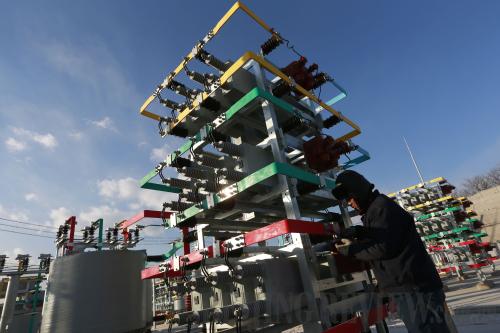|
 |
|
POWER ON: A worker installs a capacitor at a 220-kilovolt transformer substation in Qinglong County, north China's Hebei Province. This is the second such substation in Hebei and it will be put into operation in 2014 (REN ZHENGLAI) |
Mapping the Future
China opened its annual Central Economic Work Conference on December 10 amid calls for stronger and more concrete reform efforts.
The meeting is set to review China's economic progress in 2013 and suggest plans for 2014, an important year for carrying out the reform blueprint adopted in November.
Li Yang, Vice President of the Chinese Academy of Social Sciences, which is a major government think tank, said China cannot wait any longer to transform its pattern of growth, and economic policies should focus on quality growth and efficiency instead of bailouts and high-speed growth in the short term.
Economists said that China's economy has entered a new era of structural slowdown, and the rate of economic growth is likely to decrease to less than 6 percent by the end of 2030.
"The structural slowdown is not a concern by itself, but it requires an adjustment of the macroeconomic policy framework," Li said.
Interest Rate Reform
China's new guideline on deposit certificates in the interbank market became effective as of December 9. The trial is part of China's loosening of controls on deposit rates following its move in July to scrap the floor limit of lending rates.
The guideline published by the People's Bank of China, the central bank, will help increase the range of debt products offered by financial institutions, so as to better prepare for the gradual liberalization of interest rates.
The offering of deposit certificates in the interbank market is expected to improve the Shanghai Interbank Offered Rate (Shibor), measuring the cost at which Chinese banks lend to one another, which will set pricing standards for the future launch of Large Negotiable Certificates of Deposit (NCD).
NCDs usually inspire breakthroughs in interest rate reform in other countries, which generally call for deposit insurance systems to be in place beforehand.
China's launch of deposit certificates in the interbank market will lower potential risks and gain experience for the NCDs before the country establishes a deposit insurance system.
A step toward fully floating interest rates, the guideline requires financial institutions to report their annual plans for the issuance of deposit certificates to the central bank before entering the market.
The central bank set the one-time minimum volume at 50 million yuan ($8.18 million), which allows banks to borrow at more stable costs in the interbank market.
The issuance will be priced in reference to the Shibor, with the maturities of fixed-rate certificates ranging from one month to a year with those of floating-rate certificates ranging from one year to three years.
Exports Surge
China's exports outperformed market expectations in November due to improved data in the United States and the European Union.
Exports went up 12.7 percent year on year in November and imports gained 5.3 percent year on year, according to the General Administration of Customs on December 8.
November's export growth is above market expectations of 7 percent, indicating improved data in the United States and the European Union, said Liu Ligang, chief Greater China economist at ANZ Banking Group.
Foreign trade stood at $370.6 billion in November, including $202.2 billion of exports and imports worth $168.4 billion.
Trade surplus hit $33.8 billion in November, the second month that China has reported a trade surplus of more than $30 billion.
Foreign trade gained 7.7 percent year on year to climb to $3.8 trillion in the first 11 months. China targeted a foreign trade growth of 8 percent year on year in 2013.
| 